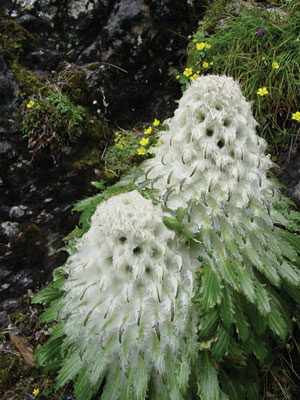Issue: 71 Page: 48
Himalayan Snow Lotus Threatened with Extinction
by Nancy Dennis
HerbalGram. 2006; 71:48 American Botanical Council
Himalayan Snow Lotus Threatened with Extinction
 |
| Snow lotus Saussurea spp. Photo ©2006 Wayne
Law. |
High in the Himalayas, well above 12,000 feet, a cottony-white flower called
the Snow Lotus grows on steep, unstable slopes. Tibetans have traditionally
used the blossoms to make medicine for high blood pressure and ailments associated
with pregnancy and menstruation.1 Tourists prize it as an ornamental
souvenir because of its rarity and unusual appearance. Bags and boxes of dried
snow lotus blossoms can be found in the markets of the Yunnan province where
it is reportedly the biggest selling herb.2
Graduate student Wayne Law has spent the last 4 years
studying the snow lotus through a National Science Foundation grant. Speaking
to National Public Radio reporter Elizabeth Arnold, Law described the snow
lotus as existing in the most extreme conditions possible for plant life and
looking like it's wearing a big fur jacket.2
Snow lotus (Saussurea spp.,
Asteraceae) is an annual, monocarpic plant (it flowers only once in its life),
with blooms lasting 3 to 4 weeks. A minimum of 7 years of vegetative growth is
required before the snow lotus will bloom. The plant is collected only while
flowering, when it has reached its maximum size (W. Law e-mail to C. Crimmons,
February 28, 2006). Law has been closely watching the particular species that
is the most prized, S. laniceps,
and reports that in areas where harvesting has taken place, he can barely find
any flowering plants. Also, the snow lotus plant itself has actually been
decreasing in size because people tend to take the very biggest plants. The
larger plants are easier for collectors to see in the wild and are worth more
money. But when the larger plants are preferentially harvested, only the
smaller plants remain to sow seeds. The snow lotus has lost nearly 4 inches in
height in a hundred years,3 which, according to Law and his advisor,
Jan Salik, PhD, Curator of Ethnobotany at the Missouri Botanical Garden, is
fairly rapid evolutionary change.2
Because smaller snow lotus plants may produce fewer seeds
than taller ones, human preferences could be pushing the snow lotus toward
extinction.4 Law and Salik hope to find out how much can be
harvested without threatening the population. People have harvested only small
amounts for use in traditional Tibetan medicine, but the modern pressure of
large world markets now threatens the snow lotus. The extinction of this plant
would represent not only a botanical loss but also a cultural loss as well.
Documentation of the traditional medicinal use of snow lotus can be found in the
oldest Tibetan and Chinese medicine books.2
—Nancy Dennis
References
1. Ethnobotany: Saussure page. Missouri Botanical Garden Web site. Available
at: http://www.wlbcenter.org/saussurea.htm.
Accessed June 13, 2006.
2. Arnold E. Saving the Snow Lotus from Extinction [transcript]. NPR Morning
Edition. February 22, 2006. Available in audio at: http://www.npr.org/templates/story/story.php?storyId=5222650.
A written transcript of the NPR story can be obtained for $3.95 at http://www.npr.org/transcripts.
3. Gorman J. The Case of the Shrinking
Lotus. The New York Times. July 5, 2005;F:1.
4. Brahic C. Snow lotus could be shrinking to extinction. Science
and Development Network Web site. Available at: http://www.scidev.net/News/index.cfm?fuseaction=printarticle&itemid=2203&language=1.
Accessed April 6, 2006.
See feature
article "Tibetan Herbal Medicine: Traditional Classification and Utilization
of Natural Products in Tibetan Materia Medica" by Alessandro Boesi,
PhD; Francesca Cardi, PhD
|